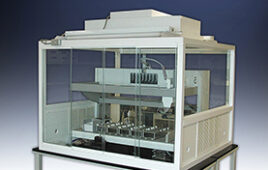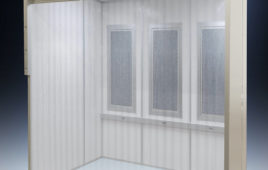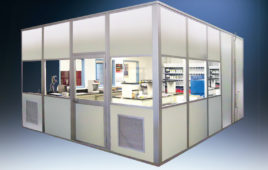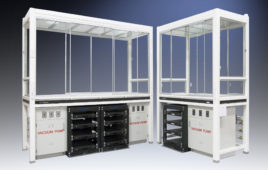 The highest possible quality of an end product, in compliance with requirements and regulations, can be attained only if quality assurance is not merely limited to final product testing. Rather, the entire manufacturing process, besides incoming quality control of the raw materials used, needs to be continuously monitored.
The highest possible quality of an end product, in compliance with requirements and regulations, can be attained only if quality assurance is not merely limited to final product testing. Rather, the entire manufacturing process, besides incoming quality control of the raw materials used, needs to be continuously monitored.
In the pharmaceutical industry, risk analysis of individual manufacturing steps is performed and the results of this analysis are used to define in-process quality control tests. Such QC tests permit timely detection of inconsistencies or non-conforming items and, in particular, increases in the bioburden as they occur in manufacture so that corrective action can be promptly initiated. Even though the risk of contamination has been considerably reduced by GMP-compliant production, decontamination, and sterilization of the end products, as well as by strict hygiene standards, quality control of the final product continues to be of prime importance.
Microbial enumeration
Quantitative analysis of microorganisms involves counting the colony-forming units (CFU), hence the term “microbial enumeration.” This number can be expressed either as the total viable number of CFUs in general or of certain product-relevant species of microorganisms. This is why microbial limit tests are performed on various products from different sectors, including the pharmaceutical, beverage, and waste water industries, to ensure that defined limits are not exceeded. The accuracy and reliability of microbial limit test results are essential as they serve as the basis for the release of products, whether potable water or pharmaceuticals, and the impact of undetected pathogens can be potentially devastating on the health of consumers.
Membrane filtration
For microbial enumeration, membrane filtration continues to be the method of choice for reliable quantification of microorganisms in liquid samples. The principle of this method is based on the concentration of organisms—which are filtered out from relatively large sample volumes—on the surface of a membrane filter and their subsequent cultivation by incubating the filter with the retained microbes on a culture medium.
Unlike direct incubation of a sample, membrane filtration offers the advantage that large sample volumes can be tested without individual microorganisms going undetected. In addition, inhibitors, such as antibiotics or preservatives, can be removed by rinsing the membrane with buffer so that microbial growth is not suppressed.
Microbiological tests in the pharmaceutical industry
From a microbiological viewpoint, pharmaceuticals can be subdivided into two categories: non-sterile and sterile products. For both categories, the potential risk resulting from microorganisms and their toxins on patients’ health must be eliminated or at least mitigated. At the same time, the quality and effectiveness of such pharmaceuticals must be retained.
Products defined as sterile, such as eye drops, physiological saline, antibiotics, etc., need to be tested for sterility (USP Chapter 71 and EP, Chapter 2.6.1) in order to be verified as such. Unlike sterile products, non-sterile end products are tested for their number of viable microbes according to the microbial limit test (USP Chapter 61 and EP Chapter 2.6.12). Furthermore, in the pharmaceutical industry, in-process microbiological quality control tests are carried out on raw materials, mostly water, as well as bioburden analysis during manufacture.
Critical steps in microbial enumeration
The classic equipment setup for performing membrane filtration consists of a vacuum pump, a multi-branch vacuum manifold, membrane filters, reusable funnel-type filter holders or single-use filtration units, culture media, and tweezers.
In this method, the filter support of a reusable filter holder is sterilized by flaming, and a membrane filter is subsequently placed on this support. Then the funnel is attached to the support and a sample is poured into this funnel. Filtration begins when the tap on the vacuum source is opened. At the end of filtration, tweezers are used to remove the membrane filter and transfer it to an agar culture medium.
The culture medium is incubated for a defined time at a predetermined temperature inside an incubator. At the end of incubation, evaluation is done by enumerating the individual CFUs and comparing their count with the permissible microbial limits for each particular sample.
Flaming or disinfecting the filter support poses an added risk of contamination due to the inherent inaccuracy in performing these sterilization procedures. In particular, maintaining the required time of contact with the flame or disinfectant, the choice of disinfectant (not just a bactericide, but a sporicide) and regular changing of the disinfectant are all critical factors in determining whether sterilization is 100% effective. Besides representing a health hazard for lab personnel, flaming also poses the risk that not all areas contaminated by microbes are exposed to the hottest point of the flame long enough in order to kill off these organisms.
Minimization of secondary contamination
A single-use filter unit does not require any decontamination, provided that a single-use filter base is used. As a result, the only especially critical step that remains is transferring the membrane filter to an agar medium, which increases the risk of secondary contamination and can lead to false-positive results. The reason lies in the use of tweezers to transfer the membrane. Although these tweezers are also flamed, i.e., sterilized, they can potentially carry over exogenous microbes when used to grasp the membrane.
Single-use filter units increase the safety and efficiency of microbiological quality control by eliminating the need for disinfection or flaming of the filter support, as well as for using tweezers to transfer a membrane to a culture medium. A system comprised of single-use filter units and agar media dishes can increase efficiency and reliable results.
The filter unit in this type of system is a sterile, ready-to-use combination of a funnel, a filter base, and a gridded membrane filter. This filter unit is connected to a stainless steel multi-branch manifold in order to directly filter a sample. Afterwards, the filter unit is easy to remove from the manifold and eliminates the critical step of decontaminating the stainless steel base of a reusable filter holder.
Agar media dishes are used for microbial limit testing. They are pre-filled with different types of agar medium, sterile-packaged and, when together with a single-use filter, are ready to use immediately. In combination with a single-use filter unit, these media dishes feature an active lid that permits touch-free transfer of a membrane onto agar, without using any tweezers. This active lid lifts the membrane filter from the base of the filter unit so the filter can be safely transferred onto the pre-filled agar dish. Once the medium dish is closed, the membrane is ready to incubate.
Solution for safe membrane transfer
The combination of agar media dishes and filter units represents a new membrane transfer and agar concept. As just a few steps are all it takes to proceed from sampling to incubation, a single-use system of agar media dishes and filter units accelerates workflows, making them cost-efficient. At the same time, touch-free membrane transfer enables even more reliable results to be obtained in analysis, while reducing secondary contamination to an absolute minimum.
Dr. Jasmin Grigat is Product Manager, Microbiology, Lab Products & Services with Sartorius Stedim Biotech GmbH. Since 2009, Dr. Grigat has been involved in products for microbial quality control at Sartorius. [email protected]; www.sartorius.com/microsart
This article appeared in the June 2014 issue of Controlled Environments.




